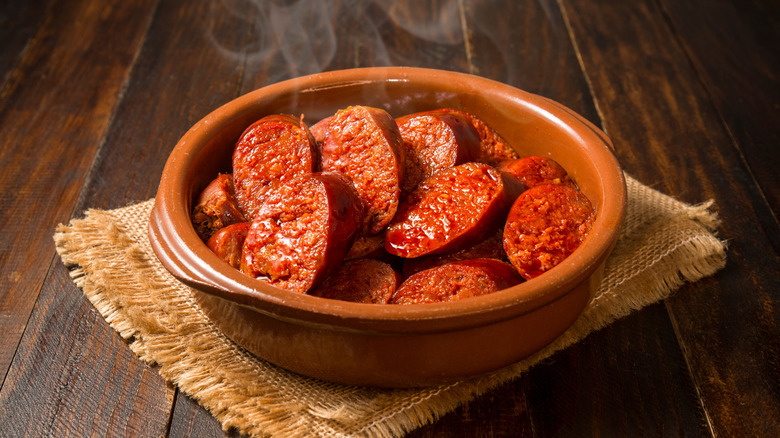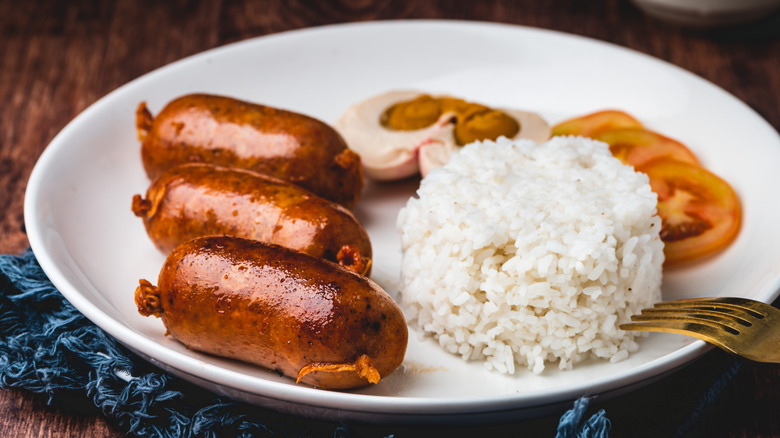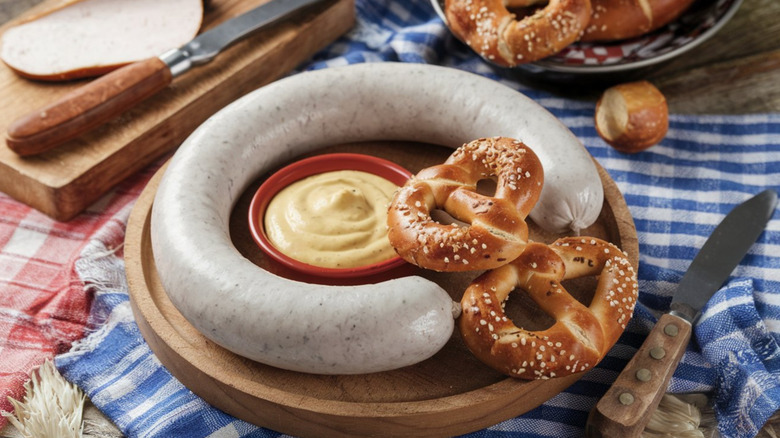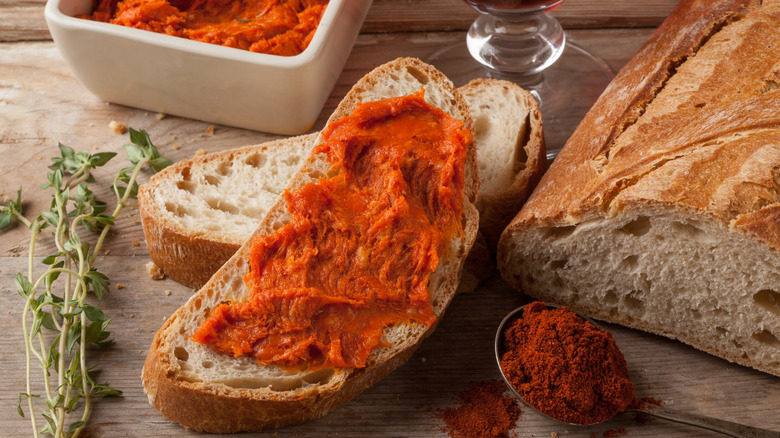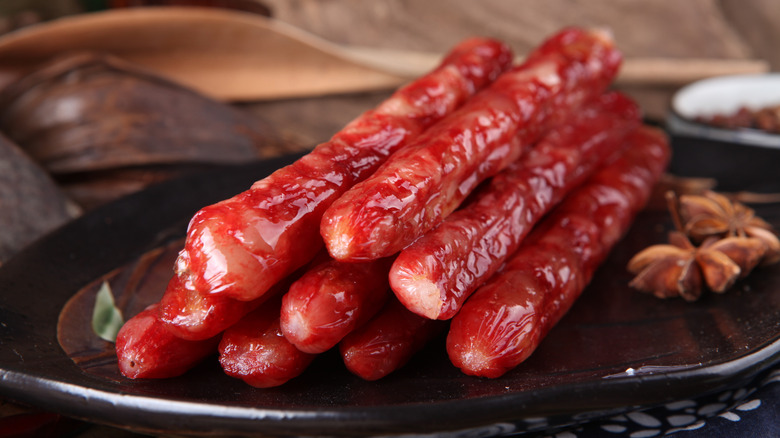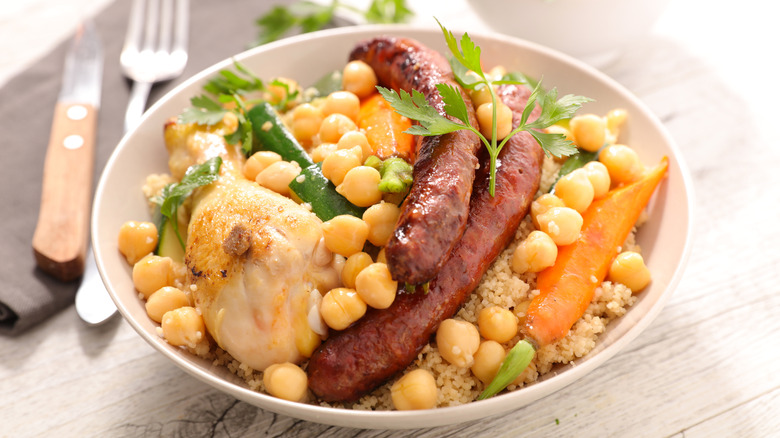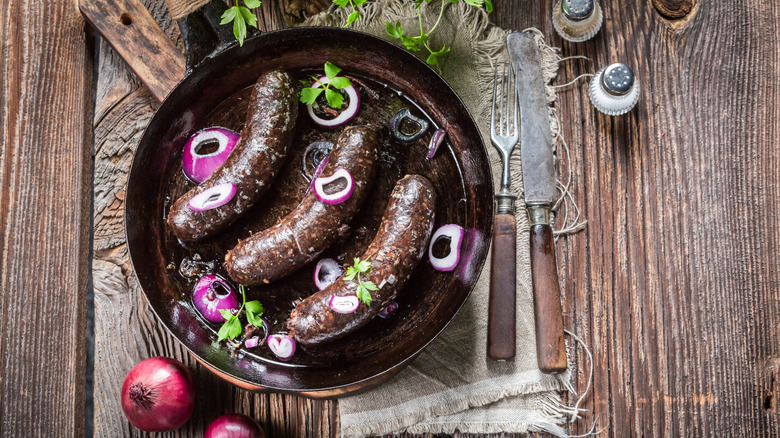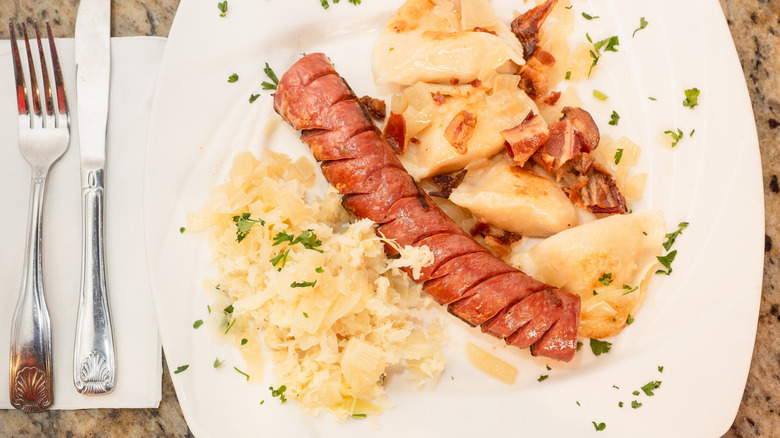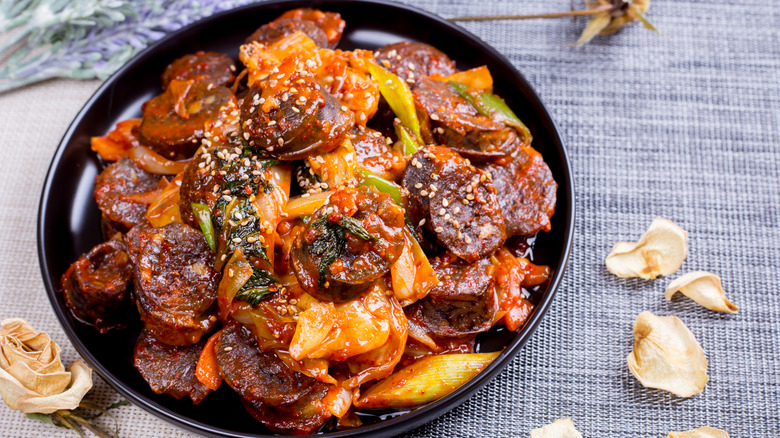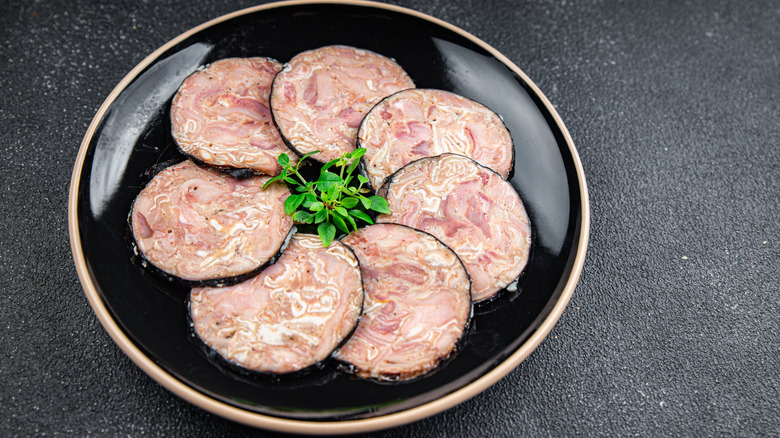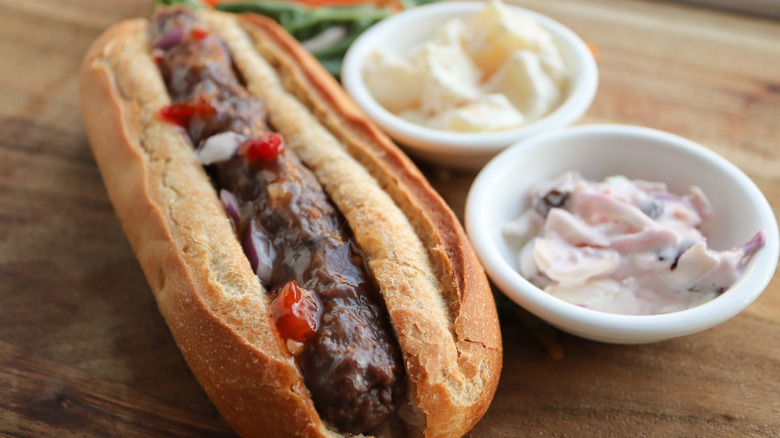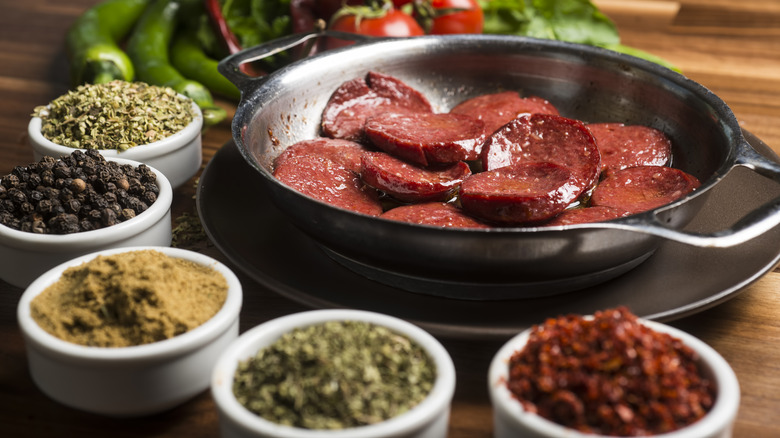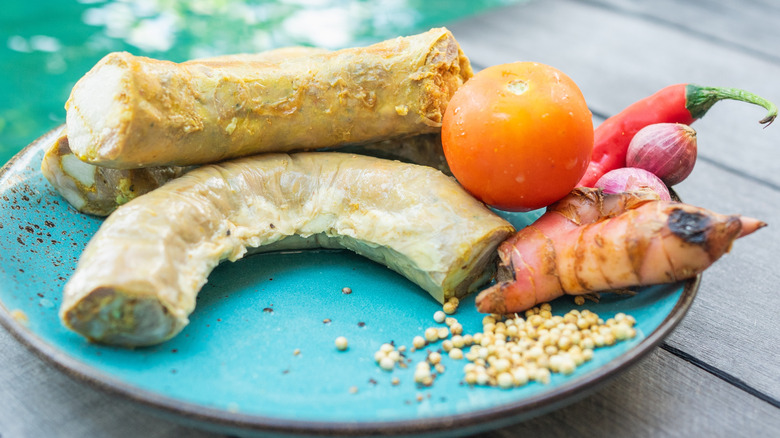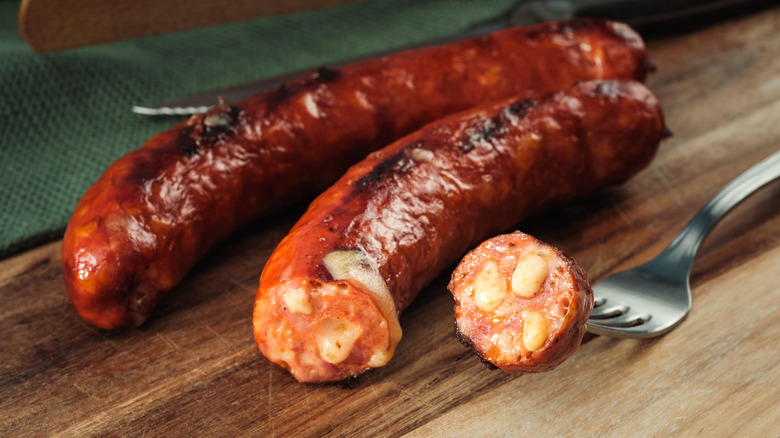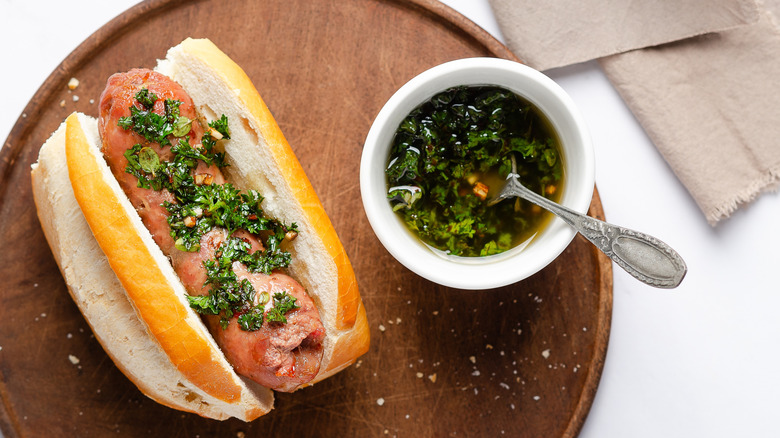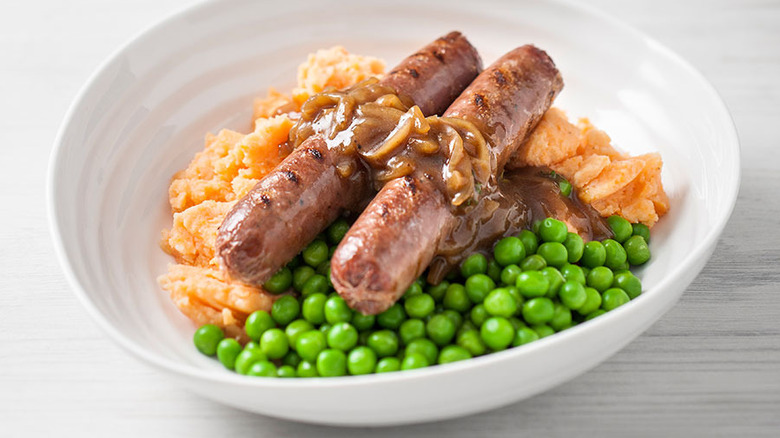International Sausages You Need To Try At Least Once
Whether it's summer grilling season or winter stew season, few meats are as comforting and versatile as sausages. Sliced in pasta, presented on a charcuterie board, or sandwiched in a bun with your favorite condiments — there are countless ways to eat a sausage, and innumerable ways to make them. While the history of hot dogs is intertwined with the United States, nearly every country has at least one sausage variety they call their own.
So where did this beloved meat specialty originate? The word "sausage" is derived from the Latin term "salsus," translating roughly to "salted." But the origin of sausages goes back even further — stone tablets of cuneiform text from ancient Mesopotamia include a description of meat stuffed into intestinal casings. The Babylonians were believed to make sausages using fermentation techniques, while ancient Egyptians made blood sausages from sacrificial cattle.
As an effective means of utilizing every last piece of meat and preserving it through salting and smoking, sausage has prevailed through millennia while spreading far and wide. At its most basic, a sausage is chopped or ground meat wrapped in casing — but beyond that, the variations are endless. The meat can be nearly any animal protein, and it's mixed with regional ingredients, spices, and herbs. To limit your sausage palate to the hot dog is a waste when there are so many international varieties to try. Here's a road map for tasting sausages from all around the world.
Chorizo (Spain)
Spanish chorizo is primarily made with chopped pork meat, pork fat, garlic, and salt. But what makes it distinct is the use of a paprika variety known as pimenton, which turns the sausage a deep shade of red. Another characteristic of Spanish chorizo is that it's ready to eat, since it's typically fermented and air-cured for up to three months. The difference between Spanish and Mexican chorizo is that the latter variety needs to be cooked prior to eating, and Mexico's version is also seasoned with vinegar and chili peppers.
There are also many chorizo variations within Spain, depending on the region. Chorizo de León is known for its smoky kick and firm texture, while chorizo Extremadura includes baked potato within its casing and can be spread on bread slices. Since Spanish chorizo is cured and ready to eat, it's a common charcuterie board item and tapas dish.
Longanisa (Philippines)
This staple sausage in the Philippines is typically small, but packed with flavor. Longanisa (also spelled longganisa) dates back to the 16th century, when Spanish occupiers introduced pork sausages called "longaniza" to this chain of Pacific islands. The name evolved slightly over the years, and the term is now used generically to describe numerous types of Filipino sausages.
While there are many kinds of longanisa, most fall into one of two categories: "recado" (savory) or "hamonado" (sweet). Specific varieties originate from different regions of the country — Lucban longanisa in Quezon province, for example, is seasoned with oregano and paprika, while Calumpit longanisa has a more well-rounded flavor with brown sugar balancing the use of garlic, salt, and pepper.
Filipinos have many ways of eating longanisa. While it's very popular at breakfast — cooked until golden brown and served with fried eggs and garlic rice — you'll find it served at lunch and dinner too, and even in wedding meals.
Weisswurst (Germany)
From bratwurst to frankfurters, sausages are a beloved icon of German cuisine, and many of the country's traditional varieties are increasingly easy to find beyond its borders. But one lesser-known German sausage that should not be overlooked is weisswurst. Translating to "white sausage," this Bavarian specialty is a short, light-gray sausage made with finely minced veal and back bacon. Don't let its pale color deceive you — weisswurst is not lacking in flavor, thanks to the addition of parsley, onions, and fresh lemon, as well as ground spices like nutmeg, cardamom, and ginger.
Legend has it that weisswurst was invented by mistake in 1857, when a Munich innkeeper thought to use pork casings as a solution after running out of the usual sheep casings for his veal sausages. Over 150 years later, this white sausage prevails across Germany, where it is often eaten as a mid-morning snack, or in pairs for a meal accompanied by a bready pretzel, sweet mustard, and a cold glass of wheat beer. To eat it like a local, cut off the tip and suck the meat out of its casing.
'Nduja (Italy)
This soft, spreadable sausage has been popping up on American menus lately, prompting many restaurant patrons to wonder, what is 'nduja? However, Italians are quite familiar with it, having been eating 'nduja since the early 1800s. In the southern region of Calabria, this sausage was created by pig farmers seeking an alternative to tossing out less-desirable swine parts, like the intestines, lungs, and stomach. These creative farmers added Calabrian chilies to provide a fiery kick, and it's this ingredient that continues to flavor 'nduja today.
Another distinct feature of nduja is that it's spreadable — due to its higher fat content compared to other sausages — and fermented, giving it a bit of funk. The sausage can have varied characteristics based on the amount of time it's aged; younger 'nduja is more acidic and spicy, while older 'nduja has had more time for the heat to subside and the smoky pork flavor to develop. Due to its soft texture, 'nduja dissolves when heated, so it can work well when added to dishes at either the beginning or end of cooking.
Lap cheong (China)
In China, sausage-making traditions are believed to date back around 1,500 years, to the era of the Northern and Southern Dynasties. Lap cheong can have varied ingredients that are unique to different regions of China — the Canton region specializes in producing sweeter sausages flavored with soy sauce, salt, and sugar, while lap cheong from Sichuan is typically spicy. The type best known in the U.S. is Hong Kong-style lap cheong, made with lean pork. Rose wine or rose-infused spirits are commonly used to season these traditional delicacies. In many households across China, families gather to make lap cheong to enjoy during Lunar New Year festivities.
While this sausage can be made at home, the process is time-consuming, as the sausage is air-dried in a cool environment for a few days or even weeks. Lap cheong can be consumed either hot or cold, but it should always be cooked first. Compared to other types of sausages, lap cheong has a firmer texture, making it an ideal addition to stir-fries and rice dishes.
Merguez (Algeria)
This African sausage delivers intense flavor thanks to its seasonings, which typically include garlic, sumac, fennel, and cumin. But what sets this delicacy apart is that it features harissa, a spicy condiment made from red chilies, giving it a bright scarlet color.
The slender sausage was born in the sprawling Maghreb region of North Africa, and while merguez is popular in several countries, it's considered as a specialty of Algerian cuisine. Because the region has a sizable Muslim population that refrains from eating pork, this meat is never included in merguez. Lamb or mutton is most commonly used to fill merguez, although beef or veal are additional options. Variations include merguez dawwara — which is stuffed with veal organs before being sun-dried — and merguez sayim, enhanced with cinnamon and dried rose petals.
In merguez, the gamey flavor of lamb is balanced by the robust seasoning blend, and the sausage boasts a smooth texture due to its meat generally being ground twice. The versatile specialty shines in classic North African dishes such as couscous and tagine.
Black pudding (United Kingdom)
This treasured sausage combines pig's blood and onions with seasonings like nutmeg, thyme, and mace in a casing made of tripe skin. The addition of grains — typically oatmeal or barley — makes black pudding a hearty specialty enjoyed with many meals.
Though blood-based sausages date back millennia in varied cultures, black pudding is a part of British cuisine since the 1400s or earlier. Over the centuries since then, this sausage has flourished across the United Kingdom and beyond, with distinct variations found in certain regions. Scottish black pudding uses steel-cut oats to create a rougher texture, while in Canada, French-Canadian black pudding — known as boudin — is made in a loaf pan instead of sausage casing.
The use of grains gives black pudding a chewy and crumbly consistency, while the combination of blood and spices imparts a subtly sweet flavor. Across the U.K., black pudding is a breakfast staple served alongside toast, baked beans, and eggs.
Kielbasa (Poland)
Kielbasa is the Polish sausage that found an American home, with a well-known U-shaped version of it found at supermarkets from coast to coast. But in Poland, kielbasa is a generic umbrella term for all kinds of sausage. One of the most traditional varieties is kielbasa wędzona, which involves cold-smoking the meat for at least a day after seasoning it with salt, pepper, sugar, and garlic. Another popular variety is kielbasa wiejska (known as "farmhouse sausage"), which is flavored with garlic and marjoram, with wild game or veal occasionally added to its signature pork filling.
Beyond these common kielbasas, Poland boasts over 100 varieties — from full-bodied kiełbasa myśliwska ("hunter's sausage") made with juniper berries to aromatic kiełbasa weselna ("wedding sausage"), which is smoked two times and contains pork, sugar, garlic, and black pepper. While kielbasa in the United States is usually sold ready to eat, you can still cook it further. Its smoky, garlicky flavor makes it a hearty addition to soups, stews, and perogies, and it's best served with sauerkraut.
Sundae sausage (South Korea)
Similarly to black pudding, Korean sundae sausage combines blood with starchy ingredients, resulting in a chewy texture. In South Korea, where it's commonly known as soondae sausage, this staple protein is typically made from pork blood, glass noodles, and rice, and it's often enhanced with iconic Korean foods like perilla leaves and kimchi. The delicacy is believed to date back hundreds of years to Korea's Goryeo dynasty, at which point it was produced from wild boars. Today, you'll find sundae sausage served at restaurants and street stalls across South Korea.
Stuffing variations can include barley or mung bean sprouts, along with seasonings like sesame seeds and sugar. The inclusion of seafood — like minced shrimp — can give it a pleasingly fishy flavor. The chewiness of sundae sausage gives it a texture that some liken to mochi. Sundae sausage can be steamed, boiled, or fried, and you'll find it starring in several Korean dishes, such as sundaeguk soup and sundae bokkeum stir fry.
Andouille (France)
This French specialty traveled across the Atlantic to become a cherished delicacy of the American South, as well. On this side of the ocean, andouille is commonly associated with the Cajun food of Louisiana — but its origins are in the Brittany and Normandy areas of France, where butchers found that oft-unwanted cuts of tripe and chitterlings were filled with flavor, and could be packed into meat casings. After French immigrants brought this sausage to the New World, the recipe evolved to be stuffed with pork shoulder instead of intestines, to include flavorful cayenne, and to be smoked instead of poached.
Today, both France and the United States boast a variety of andouille sausages. Regional variations differ across France, but one of the most coveted types is known there as andouillette, and is filled with pork tripe, onions, nutmeg, and Champagne. While French andouille is typically pan-fried, it can also be baked or grilled. Cajun-style andouille tends to be spicier than its European counterpart. Since Cajun andouille is pre-cooked, it's an easy addition to a charcuterie board, and it's also a welcome ingredient in classic New Orleans dishes like jambalaya and gumbo.
Boerewors (South Africa)
This distinctive beef sausage — seasoned with coriander, nutmeg, cloves, pepper, and salt — is believed to date back to the mid-1600s, when the Dutch first arrived in South Africa. Their descendants became known as Afrikaners, and the name of boerewors is a combination of the Afrikaans words "boer" ("farmer") and "wors" ("sausage"). Today this meaty delicacy is a staple of this nation's cuisine. South Africans take the sausage so seriously that its production is strictly regulated — any meat labelled "boerewors" must contain at least 90% meat and 30% fat.
Beyond the standardized meat composition and base ingredients of this sausage, the specific ratio of seasonings will vary depending on the region where it's made. But all across the country, you'll find boerewors cooked at South African barbecue gatherings known as a braai, where it's served with a popular polenta-like side dish called pap, or even in a bun like a hot dog. This sausage's spicy, deep flavor makes it a perfect pairing with South African chakalaka, a chunky stew made with beans, bell peppers, carrots, chilies, and other vegetables.
Sucuk (Turkey)
This popular Turkish sausage typically combines ground beef with cumin, sumac, garlic, cayenne, black pepper, and salt. After the mixture is stuffed into casings, the sausage is hung to dry and ferment for a few weeks. This lengthy curing process allows the flavors of sucuk to deepen and sausage to harden.
Variations of sucuk can include lamb in addition to beef — but you won't see it made with pork, because Turkey has a large Muslim population that is prohibited from eating pork under Islamic law. Outside of Turkey, regional varieties include goat-stuffed sucuk in the Balkans, while this sausage is made with horse meat in Kazakhstan and Kyrgyzstan. The complex spice profiles of susuk make it delicious at any time of day, but you're most likely to see it served with a traditional Turkish breakfast — especially in sucuklu yumurta, an egg dish prepared by frying the sucuk in a skillet, and covering it with eggs once crispy. For dessert, a meat-free sweet called cevizli sucuk is not actually a sausage, but a string of walnuts dipped into grape molasses and hardened to look like classic sucuk.
Urutan (Bali)
This Balinese sausage mixes pork fat, meat, and intestines with seasonings like ginger, turmeric, garlic, shrimp paste, and galangal, creating an aromatic sausage loaded with flavor. Aside from urutan's unique blend of flavorings that balance out savory and sweet elements, what sets this sausage apart is its rough consistency, a result of the meat being cut unevenly in the preparation process.
Urutan falls into two categories, depending on how it's made. It can either be freshly made and deep-fried before being eaten right away, or fermented by being hung outside in the sunshine for two days, during which time the spices fully infuse into the meat. Since the latter variety is fermented, it lasts longer than freshly made urutan.
From street food stalls to restaurants to religious ceremonies, you'll find urutan served all across Bali. It's frequently included in fried-rice dishes such as nasi goreng, or served with sambal matah, a spicy Balinese condiment similar to salsa.
Käsekrainer (Austria)
Combining the German words "käse" (cheese) and "krainer" (a type of sausage), this Austrian delicacy is exactly what its name describes — a sausage stuffed with cheese. After the casing is filled with pork and small bits of Emmental cheese, the sausages are smoked over applewood, all resulting in a savory, rich flavor.
These sausages are commonly grilled to achieve a crispy exterior, although they can also be baked or boiled. While the käsekrainer is being cooked, its cheese chunks melt to create an oozing effect when the sausage is cut open, which is one of the appetizing elements that makes this sausage popular among locals and visitors alike. It's also what explains the less-than-appetizing alternative German name for this sausage, "eitrige" — which translates to "ulcerous" or "pus-filled."
Don't let that nickname turn you off — this cheesy sausage is delicious, and frequently served with slices of bread and condiments like mustard, horseradish, curry sauce, and ketchup. Käsekrainer is sold everywhere in Austria, from street food stands to sports matches, and it's often served like a hot dog in a baguette-style roll.
Salchicha parrillera (Argentina)
Made with pork, paprika, garlic, and oregano, salchicha parrillera is considered to be a longer and more slender version of Spanish chorizo. In Argentina, the word "parrilla" can refer to either the grill itself or a gathering place where barbecued meat is prepared and served. Open-air grilling and utilizing every cut of meat is part of Argentina's culinary tradition, dating back to the 18th-century gauchos, making this sausage an integral part of the nation's culture.
You'll find salchicha parrillera commonly served at an Argentinian barbecue get-together known as an asado, where the sausage is arranged into a spiral and held together with skewers on the grill. At this kind of social event, the sausage is usually part of a larger spread of grilled meats, or as an appetizer topped with provolone cheese. After it is grilled until crispy, the sausage is also served as a tapas dish, or with bread and traditional Argentinian chimichurri sauce.
Kanga banga (Australia)
Of all the snags (the Australian slang word for sausages) that you'll find Down Under, kanga banga is one of the leanest varieties. This is because these sausages are made with kangaroo, which provides a low-fat meat that can only be harvested by hunting the jumping marsupials in the wild. Compared to typical sausages made with pork or beef, kanga banga not only provides an alternative that's lower in fat, but it also contains health-boosting omega-3 fatty acids and vitamins.
The low fat content of kanga banga sausages makes them easy to overcook, so they're best prepared on the medium-rare side. With a strong flavor comparable to game meat that is rich with umami taste, it's a sausage unlike any other. You'll find it served at a sausage sizzle (aka an Australian barbecue gathering), or in an Australian sausage sandwich that's playfully called a kanga banga sanga, frequently topped with grilled onions and condiments like mustard and mayonnaise.

